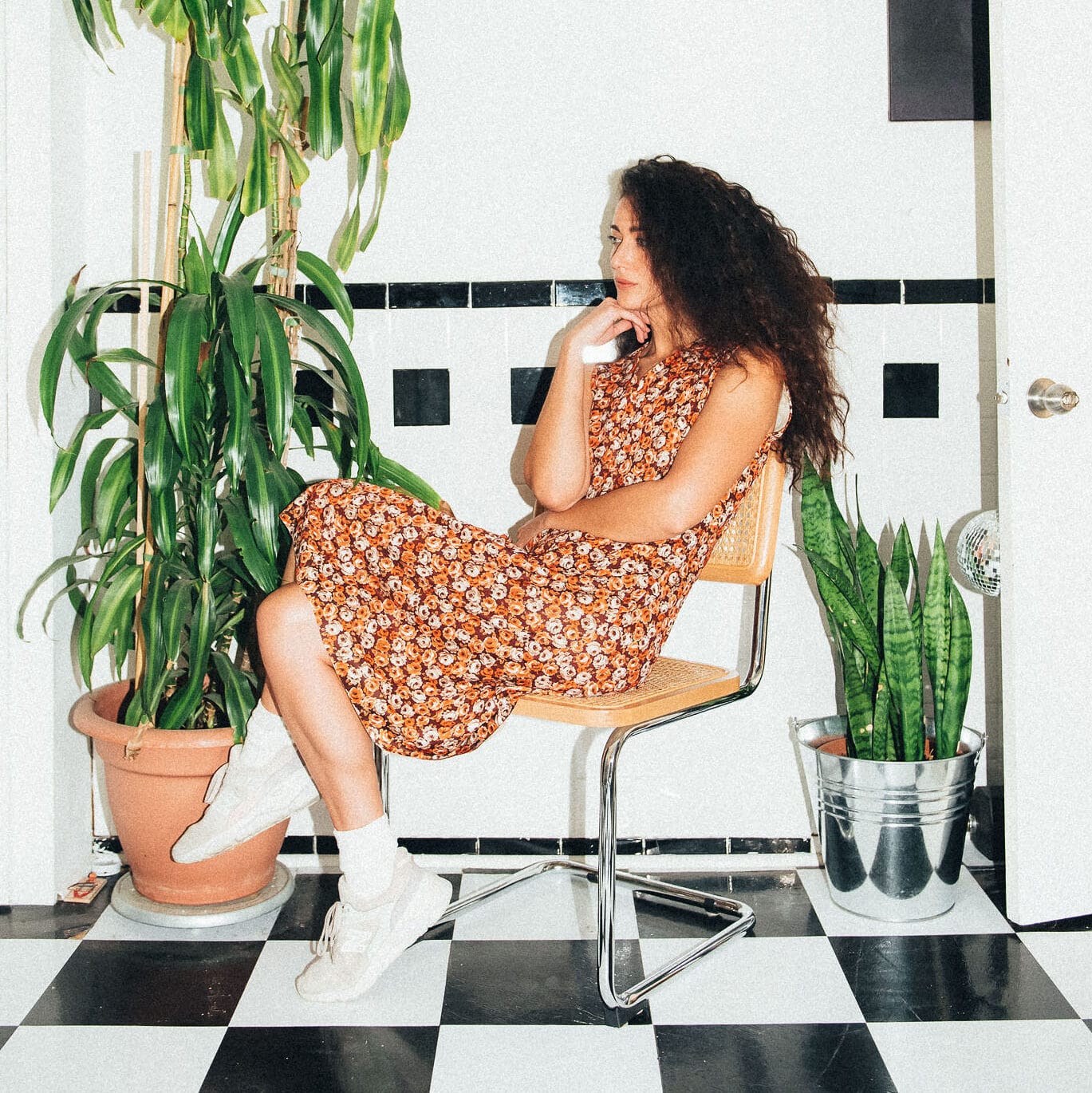Front-lawn fountains. Big floral housedresses. Socks with Dr. Scholl’s sandals. White doilies everywhere. Family recipes learned only through cooking with nonna.
For many Italians (and Italian-Canadians), these were the hallmarks of their parents’ and grandparents’ generation. For Ariane Laezza, they’re iconic features of Italian culture, and — dare we say — maybe even cool.
Laezza is the creator of Nonna Life, a brand celebrating Italian nonnas and their “strength, style and simple approach to life”. On her Instagram account, @thatnonnalife, Laezza immortalizes throwback Italian culture, mixing photos of sugo-making Sundays and wood-panelled ‘70s basements with memes about Jolen bleach (if you know, you know).

Laezza, who has a background in fashion, also parlays that retro vibe into a line of nonna-inspired dresses made from vintage Italian fabrics, and she’s looking to expand into the food world, too.
But at its heart, Nonna Life is about promoting a simpler way of living and paying tribute to the resourcefulness and resilience of previous generations of Italians, including Laezza’s own beloved grandmother.
The result is an ever-changing mood board of Italian culture that’s both irreverent and heartfelt — one that Laezza says has inspired fellow third-generation kids to take pride in their heritage.
We sat down with Laezza to discuss grandparents’ hipster appeal, learning to cook nonna-style, and why the floral muumuu is due for a comeback.
What prompted you to launch Nonna Life?
I started it in early 2019, after my nonna had passed away in late 2018 — she was 94. She was here with us in Toronto for the last years of her life, and we got a lot closer. I could sense it was getting to the end, and I really dedicated myself to talking about past stories and experiences, really getting her insight on food and style, that sort of thing.
I had been feeling really overwhelmed with work when she passed, and I thought that I needed to revisit a back-to-basics sort of approach to life. I wanted to reclaim the lessons I was brought up with — lessons that I think a lot of people who learned them growing up tend to forget in a modern lifestyle. I saw it as a way to explore those life lessons, how to simplify your day-to-day life. Once I started revisiting these things, I felt a bit more at peace, a bit less frazzled.
In terms of food, it’s revisiting “real” foods — really good ingredients, things that you put in your body that will make you feel better. It’s also about revisiting old, traditional recipes that I had never learned to make, but I told myself, “I’m going to lose this if I don’t.” On the fashion and style side, it’s about revisiting this idea of wearing what you have, reworking things that are already in existence. Overall, it’s about a really holistic, thoughtful way of living.
I also wanted to explore this idea of Italian culture through the eyes of nonnas specifically. A lot of the time the nonnas came over alone with the kids on the boat, like mine did, while the dads were working. It’s this crazy strength and determination that that generation of women had. They’re sort of feminist icons in my mind.

Often when people do cultural projects based on preserving their culture or their family history, there’s a very reverent, nostalgic, serious tone – rarely do you see people saying “Oh, yeah, my grandpa had swag”. Can you talk about why you decided to focus on that cool factor?
I think Italians are hilarious people. We all have a really good sense of humour, and there’s a lot of sarcasm and playfulness that’s part of the culture. I wanted to communicate that somehow.
I always thought my grandparents had the coolest style. The New Balance sneakers that are cool these days – I remember my grandfather wearing them, and I always thought they were cool. I think in the last year there’s been a return to grandparent fashion — the “normcore” thing sort of brought it in. I still wear my grandfather’s button-down shirts with jeans and a pair of boots. And with my grandmother, there were all the floral dresses. I remember even thinking growing up, “This could be cool! I could make this kind of sexy, maybe!”
That’s why I ended up starting to design dresses based on their housedresses. I always thought they were really stylish. My mom laughed when I started doing it – she was like “Oh no, those were so ugly!” From her perspective they looked really old-lady. I’m like “Yeah they do — and that’s cool!”
So much of the Instagram account revels in these really specific, sometimes obscure details of what it’s like to be Italian. I think my grandparents had those exact same white plastic chairs you called out in a recent post.
I approach the Instagram account through this semiotic lens — things that are symbols of culture that sort of represent you — even if you’re unaware of them. I’ll give you the most Italian-Canadian example I can think of, which is hockey sticks in the garden as tomato stakes – my grandpa would use them in his garden, and I knew so many people growing up with the same thing.
I think a lot of it is because a lot of Italians came to Canada post-World War II. People came over on the same boat, moved to the same communities, went to the same church, and so there was this exchange within communities. If there was a sale on those white plastic chairs, my nonna would have called up a few people and said, “Want to go in on these with me?” I remember seeing the exact same paint colours in people’s houses over and over again. Remember those knives with the plastic brown or cream handles? Everyone had those too. There was this shared aesthetic, for sure.

Tell me a bit about the fashion element of Nonna Life.
It’s about style, but also comfort and practicality. I live on St. Clair West (in Toronto), and there’s a fabric store here called Tessuti Venezia — right next to Tre Mari Bakery. It’s closing after 60 years, and when I started making dresses, it was all using ‘60s and ‘70s Italian deadstock fabric from the shop. I actually did a shoot there, too. I like to think that there were ladies looking at these fabrics 30 or 40 years ago, and now I’m using them.

Also, people are at home more now! This style is perfect for Zoom calls, because they have a collar. You can look presentable if people call you out of the blue, but you’re still cozy.
I’ve always thought old people have really cool style. They come from an era where if you left your house, you’d have a certain pair of shoes, your hat, your coat, your bag. They had staples, and I like the idea of having staples.
Right now we’re developing some new mini campaigns around the dresses — one of them is the snowbird collection, inspired by going down to Florida in the wintertime.
How does food integrate into the project?
Right now, I’m on a bit of a personal journey with my family, learning to cook through some of my nonna’s recipes, and documenting it on Instagram.
Growing up, I think I took my nonna’s food for granted – I think a lot of us do. Then there was the joy that comes from always having food out, people being in the kitchen, having good conversations. I’m really nostalgic about that now that my grandparents have all passed. Now I’m revisiting these family recipes, it’s like reconnecting me to those days.

I will mention that I’m not the biggest cook — I did this as a way to ensure that I learn first-hand to make all these things, and I’m really trying to be open about the fact that I’m just learning and sharing these recipes. My dad and I are still making the recipes nonna left behind — though as with many grandmothers, she never REALLY left a recipe behind. It was always a handful of this, a dash of that.
When it comes to ingredients, like cheeses, I try to get the best-quality stuff I can. My husband used to work in wine and spirits, and it’s the same thing with wine. We always make sure that if we’re getting something, it’s from the region it’s from, and there’s a respect on how it’s made.
As much as I can, I want the ingredients I use to be from where they’re from. I don’t want the imitation — I want things that are made how they should be. I use really simple ingredients, so I’m always trying to get the best version of whatever it is.
I want to do a book at some point about traditional recipes and the traditional approach to living, and I’m planning on doing some content on getting tips from other nonnas on how to perfect recipes. You’ll probably see more food content coming up in the next few months or so.
How has the response to the project been so far?
It’s been really special, because it makes me feel really nice to see that what I’m putting out resonates. You should see my DMs, especially from the beginning of the project. People were telling me their grandparents had recently passed, and were sending me these photos of their grandparents along with stories.
I had someone message me and say, “I’m Italian, I grew up in a very Canadian neighbourhood where I tried to hide my Italianness, and in a lot of ways, I was almost ashamed. Seeing some of your posts, I was like, ‘Hell no, I’m Italian,’ and now I’m at a point where I’m proud of this heritage.” It made a big impact, and I thought that was really special to hear.
If you do what you know, and you share what you know, that’s what’s going to resonate. Like, “I know all this in my cells, I can feel it.” This is your history, this is your culture, this is your experience — and if it hits other people in the same way, you’ve done your job.
This interview has been edited and condensed.



Add a comment